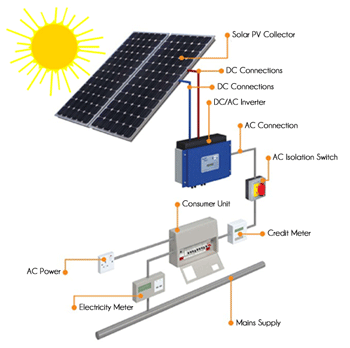
Solar PV Solutions
Free Electricity from the Sun
Solar PV is a renewable energy system which uses photovoltaic modules on the roof of a building to convert light into electricity.
Solar PV offers an affordable and practical renewable energy solution.
How does Solar PV work?

A Solar PV module is made up of mono-crystalline cells which consist of two or more thin layers of semi-conducting chemically treated silicon materials. The chemicals react when light hits the cell, creating an electric field across the layers, producing a direct current.
The greater the light intensity, the greater the flow of electricity. This direct current (DC) is then fed into an inverter which changes it into a usable alternating current (AC) producing solar energy which can used in your home.
Where can I install my Solar PV modules?
The location of the Solar PV is vitally important. The modules must receive the maximum amount of day light possible, so it is not advised to install the modules in situations where surrounding buildings or trees may cast shadows. The best location for a Solar PV module is on a south facing roof. There are various mounting arrangements including on-roof, in-roof and flat roof kits, both landscape and portrait.
What happens when the weather is cloudy or cold?
Solar PV Panels use light to generate electricity, so the modules still work when it is cloudy, although when it is overcast they are less efficient at producing solar energy. When it is slightly overcast, the panels may produce as much as half the power they would in sunny conditions. When the sky is heavily overcast, this could reduce further. Temperature is less important than how much light there is. What's more, a clear cold day is perfect, because Solar PV modules operate better at cooler temperatures.
What happens if the modules get dirty?
Solar PV modules are self cleaning when mounted at an angle of at least 15º. The amount of dirt on the modules depends on their location. If the modules are in a heavily silted area (e.g. under trees) the build up of dirt may reduce the power the panel generates by around 10%. Solar PV modules should be expected to last at least 25 years, since there are no moving parts. The Solar PV modules have a twenty-five year performance guarantee.
Can I sell the electricity I produce back to the energy supplier?
Most electricity suppliers will pay for power fed into the Grid (feed-in-Tariff) from domestic Solar PV systems. The easiest way to do this is by signing up to a 'Buy Back' or 'Feed-in Tariff' scheme with your power supplier. There are two main types of tariff available:
Generation: You are paid for all of the electricity that your Solar PV system generates even if you consume it in your home.
Export: You are paid for just the electricity that is exported back to the Grid and not for any electricity you have consumed.
What are Feed-in Tariffs (FIT)?
On 1st February 2010, the Government announced the new standard generation Feed-in Tariffs (FIT). The rates from the 1st August 2012 are now guaranteed for 20 years.
This payback scheme, results in a shorter payback for Solar PV systems, making them an extremely attractive green option for any home.
Any system less than 4kW on a new build = 16p per kW payback
Any system less than 4kW on a retrofit = 16p per kW payback
Any system 4-10kW new build or retrofit = 14.5p per kW payback
Any system 10-50kW new build or retrofit = 13.5p per kW payback
This means that if you normally pay 12p per kWh for your electricity, you would effectively get both the power consumed for free and the FIT. This is in addition to an export tar.
So on a retrofit system below 4kW this would mean 12p + 16p = 28p per kWh saving!
In addition you will also receive 4.5p per Kw Hr generated for 50 % of the electricity your system has generated.
See our on line calculator below
For more information about the feed-in tariff and other government incentives visit Solar Guide.
Any Solar PV system installed after the 15th July 2009 is eligible for this Feed-in Tariff at the above rate, provided the system uses MCS approved equipment and has been fitted by an MCS accredited installer.



